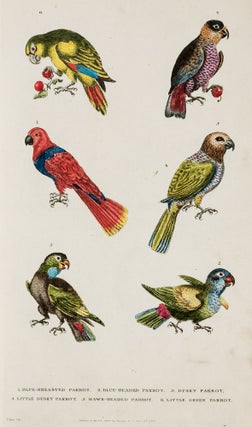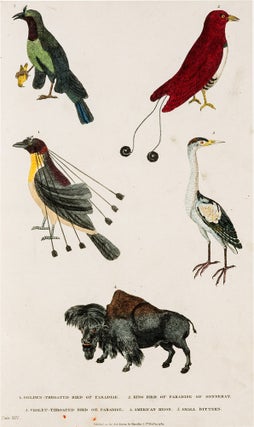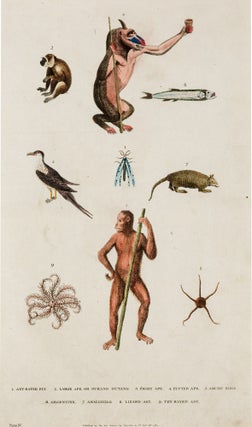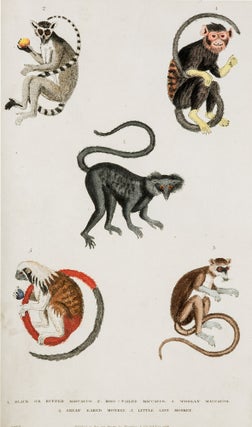A New Dictionary of Natural History; or, Compleat Universal Display or Animated Nature…
A New Dictionary of Natural History; or, Compleat Universal Display or Animated Nature. With Accurate Representations of the Most Curious and Beautiful Animals, Elegantly Coloured.
London: Harrison & Co., 1785.
Two volumes, folio, with 100 handcoloured engraved plates (most incorporating from four to eight images); title-pages printed in black and red; contemporary marbled calf, very skilfully rebacked to match, preserving original red and green labels.
The Leverian and beyond: natural history for the popular market
One of the great popular works of natural history, this beautiful large-format work is largely based on the great collection of curiosities and exotic specimens of Sir Ashton Lever, the most influential eighteenth-century collector: Lever may have been indulging his panache as a showman when he referred to his "Holophusicon" as "the first museum in the universe", but it was no exaggeration. Although the preface to the book describes how the illustrations are based on originals from the cabinets of virtuosi in "every part of Europe", it is clear that most, and almost all the newer specimens, are from the Holophusicon, which is singled out by the author as having been gathered "with the indefatigable industry, the consummate skill, and the munificent expense" of Lever himself.
One of the great popular works of natural history, this beautiful large-format work is largely based on the great collection of curiosities and exotic specimens of Sir Ashton Lever, the most influential eighteenth-century collector: Lever may have been indulging his panache as a showman when he referred to his "Holophusicon" as "the first museum in the universe", but it was no exaggeration. Although the preface to the book describes how the illustrations are based on originals from the cabinets of virtuosi in "every part of Europe", it is clear that most, and almost all the newer specimens, are from the Holophusicon, which is singled out by the author as having been gathered "with the indefatigable industry, the consummate skill, and the munificent expense" of Lever himself.
Lever employed Sarah Stone as the central artist responsible for depicting his collection, 'faithfully drawing and painting mounted birds, insects, mammals, fishes, lizards, fossils, minerals, shells and coral from all over the world, as well as ethnographical artefacts brought back from exploratory voyages, including those of Captain Cook' (Jackson, Sarah Stone, p. 9). This is particularly significant because many of the engravings in the present work, although not signed in any way, are based on originals by this important woman artist.
The work was published in 1785 at a time when the study of natural history had never been more popular, in no small part due to the exotica brought back from Cook's voyages, but also due to Lever's employment of artists like Stone; and yet, the Leverian Museum itself was in crisis, leading to its sale by lottery the following year. The present work's reliance on Lever means that it is a remarkable overview of the natural history of the era and of the museum itself at the end of its days.
The author's name "William Frederick Martyn" was the pseudonym of the indefatigable William Fordyce Mavor (1758-1837), a schoolmaster and writer of some note, who specialised in educational works, most famously his long series of abridged voyage accounts which included the voyages of Cook.
Between the larger format of the book and the fact that it was recognised as an indispensable work of reference, it is unusual to see copies in very good condition, and the present set is unusually well-preserved.
Provenance: Thomas Hammond Foxcroft of Halstead, Yorkshire, rector of Beauchamp Rooding, Essex (armorial bookplates).
Nissen, 2729; Wood, 453.
Condition Report: Slight rubbing to extremities, overall a very good set.
Price (AUD): $9,750.00
US$6,367.35 Other currencies









